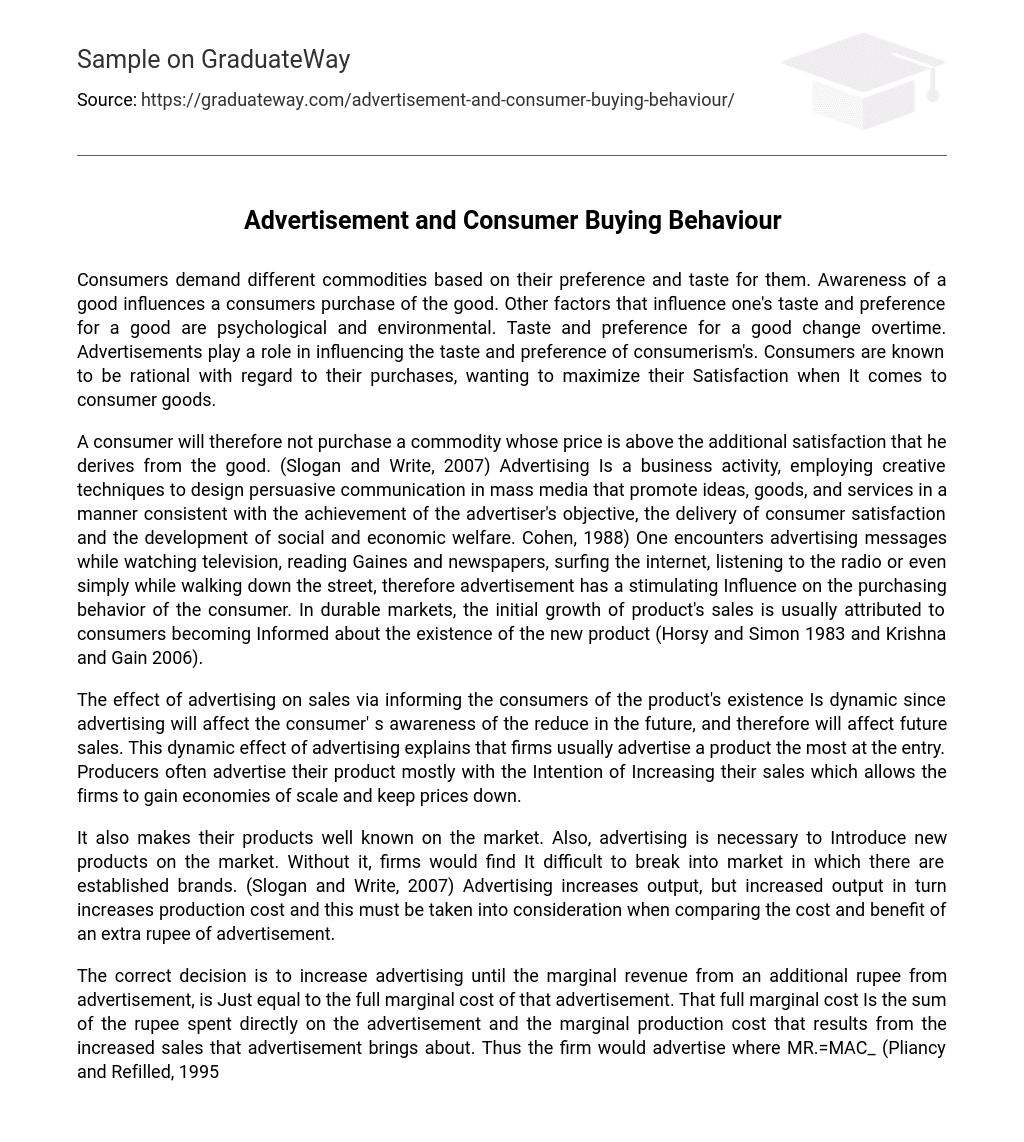Consumers demand different commodities based on their preference and taste for them. Awareness of a good influences a consumers purchase of the good. Other factors that influence one’s taste and preference for a good are psychological and environmental. Taste and preference for a good change overtime. Advertisements play a role in influencing the taste and preference of consumerism’s. Consumers are known to be rational with regard to their purchases, wanting to maximize their Satisfaction when It comes to consumer goods.
A consumer will therefore not purchase a commodity whose price is above the additional satisfaction that he derives from the good. (Slogan and Write, 2007) Advertising Is a business activity, employing creative techniques to design persuasive communication in mass media that promote ideas, goods, and services in a manner consistent with the achievement of the advertiser’s objective, the delivery of consumer satisfaction and the development of social and economic welfare. Cohen, 1988) One encounters advertising messages while watching television, reading Gaines and newspapers, surfing the internet, listening to the radio or even simply while walking down the street, therefore advertisement has a stimulating Influence on the purchasing behavior of the consumer. In durable markets, the initial growth of product’s sales is usually attributed to consumers becoming Informed about the existence of the new product (Horsy and Simon 1983 and Krishna and Gain 2006).
The effect of advertising on sales via informing the consumers of the product’s existence Is dynamic since advertising will affect the consumer’ s awareness of the reduce in the future, and therefore will affect future sales. This dynamic effect of advertising explains that firms usually advertise a product the most at the entry. Producers often advertise their product mostly with the Intention of Increasing their sales which allows the firms to gain economies of scale and keep prices down.
It also makes their products well known on the market. Also, advertising is necessary to Introduce new products on the market. Without it, firms would find It difficult to break into market in which there are established brands. (Slogan and Write, 2007) Advertising increases output, but increased output in turn increases production cost and this must be taken into consideration when comparing the cost and benefit of an extra rupee of advertisement.
The correct decision is to increase advertising until the marginal revenue from an additional rupee from advertisement, is Just equal to the full marginal cost of that advertisement. That full marginal cost Is the sum of the rupee spent directly on the advertisement and the marginal production cost that results from the increased sales that advertisement brings about. Thus the firm would advertise where MR.=MAC_ (Pliancy and Refilled, 1995) 1. 1 Statement of the problem This mammoth surge of advertisements from every possible source is basically to their product may receive optimum exposure.
The role of advertisement which is to create brand loyalty, consequently increasing sales revenue and profits of the local firms and also causing impact on the business cycle has been falling apart. (Sundaes, 2007). The subject of advertising has remained a topic of debate either on one pretext or another for decades, at the beginning of the 19th century, it was a subject of little interest but it became a fertile topic for research at the turn of the 19th century. (Sahara and Sahara, 2009).
In view of this, this study seeks to find out if advertisement plays a role in consumer demand. 1. 2 Objectives The general objective of the study is to find out if there is any effect of advertisement on consumer buying behavior. In my quest to achieve the general objective, the following specific objectives were set and formulated to guide in data collection and analysis: l. To know the extent to which purchases of consumers are based on advertisement. II. To know the growth pattern and trend of sales revenue and advertisement expenses for selected locally produced firms. . 3 Methodology This deals with the methods in terms of analytical approach and data collection. Data Analysis will be done using Stats. Data to be used are primary and secondary data. Primary data will be collected from consumers to find out how advertisement influenced their purchases and secondary data will be taken from Malls to and shops in Bangor to know the amount of locally produced goods patronized by consumers. Consumers will be selected using systematic sampling and the malls and shops on eruptive sampling 1. The rationale for the study With increasing number of advertisements on the electronic media and the print media, it has become a necessity that a research be conducted to find out if advertisements have effect on the taste and preferences of consumers’ demand and empirically, the effect on sales of firms. The research will focused on both locally produced goods and foreign brands with emphasis on two manufacturers, two other large scale trading enterprises or malls in Bangor and four hundred consumers in Bangor.
The manufacturers will provide information as to whether advertisement affects their sales level, thus, whether consumers react positively, indifferent or even negatively. The supermarkets will provide information on the percentage of locally manufactured goods available, and consumers’ attitude towards locally manufactured goods. Consumers will provide information as to whether advertisements influence their purchase of locally manufactured goods and the accessibility of these goods. They will also provide information on other factors that influence their purchase besides advertisement.





